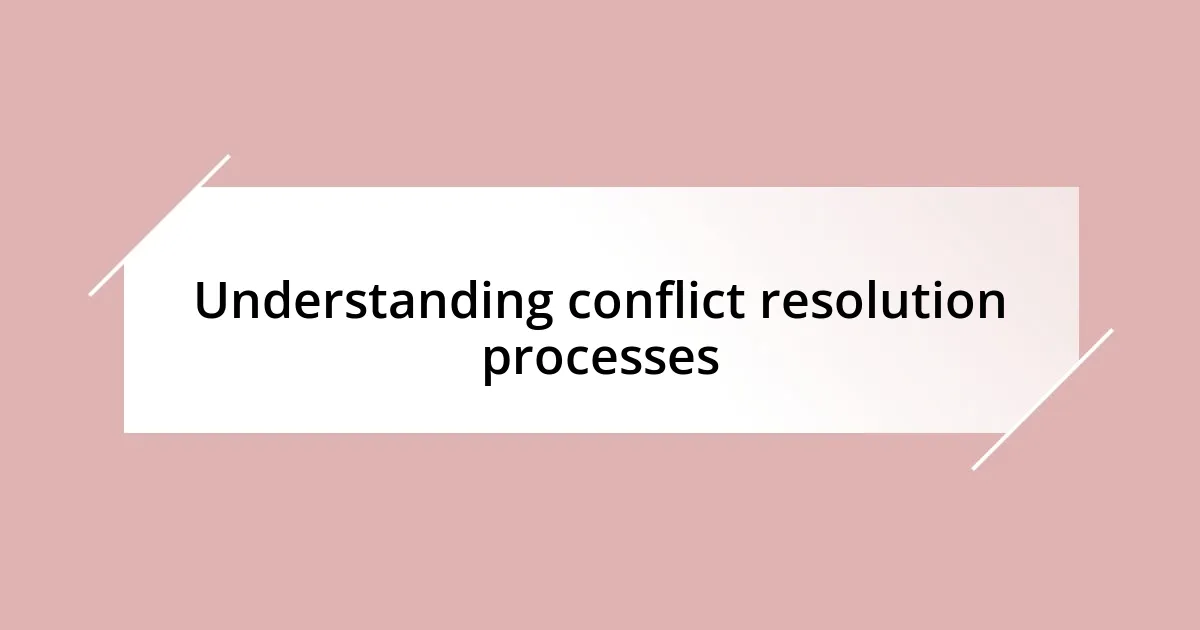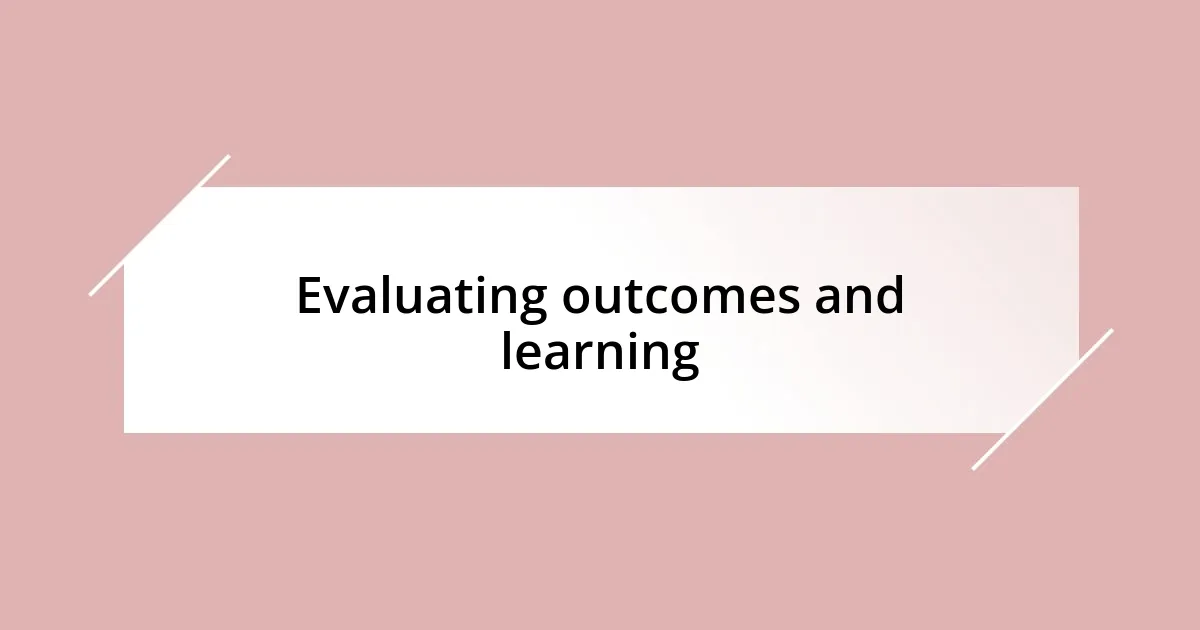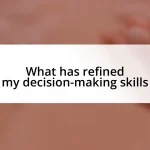Key takeaways:
- Early acknowledgment of conflicts and open communication can transform tension into collaboration.
- Using “I” statements and active listening is essential for effective communication in conflict resolution.
- Brainstorming as a team and establishing ground rules enhances collaborative problem-solving.
- Evaluating both emotional and functional outcomes of conflicts leads to improved future interactions.

Understanding conflict resolution processes
Understanding conflict resolution processes is essential for navigating interpersonal relationships effectively. I remember a time when I was part of a team project, and differing opinions nearly derailed our progress. It struck me how important it is to acknowledge conflicts early on—a proactive approach that can transform tension into collaboration.
The key stages of conflict resolution often begin with identifying the issue and encouraging open communication. Recently, during a heated discussion with a colleague, I found that listening without interrupting was more powerful than I anticipated. Have you ever experienced the relief that comes from simply being heard? It’s a pivotal moment that can shift the atmosphere from confrontational to constructive.
Another element in conflict resolution is finding a mutually acceptable solution. Personally, I’ve learned that seeking compromise often requires creativity and patience. Once, while navigating a disagreement with a friend, we brainstormed options that satisfied both of our needs. It was illuminating to see how collaboration can lead to solutions we might not initially consider, turning a conflict into an opportunity for growth and understanding.

Identifying common conflict triggers
Identifying common conflict triggers can dramatically improve how we handle disagreements. I’ve found that recognizing the underlying issues is like shining a light on shadows – it brings clarity. For example, during a discussion about project priorities, I realized that differing values about work-life balance triggered frustration in my teammates. Once we pinpointed this, it became easier for us to address the issue without letting emotions cloud our judgment.
Some common conflict triggers include:
– Miscommunication or lack of communication
– Differing values or beliefs
– Competing interests or goals
– Personality clashes
– Stressful situations or external pressures
Understanding these triggers doesn’t just help in conflict resolution; it also fosters a more harmonious environment. When I began to notice these patterns, it was enlightening to see how simply acknowledging them could diffuse tension before it escalated. For instance, by addressing a team member’s need for recognition early on, I could transform potential resentment into appreciation, paving the way for smoother collaborations.

Effective communication techniques in conflict
Effective communication techniques play a vital role in resolving conflicts, as they can turn tension into productive dialogue. One technique I’ve found invaluable is using “I” statements. Instead of saying, “You always interrupt me,” I learned to express my feelings by saying, “I feel overlooked when I can’t finish my thoughts.” This shift not only communicates my emotions but also encourages the other person to understand my perspective without feeling attacked. Have you ever noticed how subtle changes in phrasing can significantly alter the tone of a discussion?
Active listening also stands out as a crucial technique in conflict resolution. There was a situation where a friend and I had a disagreement over weekend plans. Instead of jumping in with my own opinions, I took a moment to reflect back what they were saying. I asked questions to confirm my understanding, which made my friend feel appreciated and heard. This approach transformed our conversation into a collaborative problem-solving session instead of a battleground.
Another effective technique I’ve adopted is maintaining a calm demeanor. I recall a tense meeting where frustrations were running high. By taking deep breaths and speaking slowly, I found that I influenced the emotional tone of the room. People began to mirror my calmness, and the tension eased significantly. Maintaining composure can invite others to do the same, paving the way for clearer, more constructive conversations.
| Communication Technique | Description |
|---|---|
| I Statements | Communicate feelings without placing blame, fostering understanding. |
| Active Listening | Engage fully by reflecting and confirming what the other person says. |
| Calm Demeanor | Maintain composure to influence the emotional tone and ease tensions. |

Strategies for collaborative problem solving
When it comes to collaborative problem-solving, one strategy that has consistently served me well is brainstorming as a team. By inviting everyone’s ideas to the table, I’ve witnessed firsthand the surge of creativity that can occur. There was a time when our team faced a major roadblock on a project. Instead of letting frustration fester, we scheduled a brainstorming session. As each person shared their thoughts, it was exhilarating to see how we built off each other’s ideas, leading us to a solution that none of us would have reached alone.
Another effective strategy is establishing ground rules for discussions. I remember a heated meeting where tensions rose quickly due to interruptions. To remedy this, we made a simple agreement: each person could share without interruptions for a set time. This arrangement made all the difference—it not only ensured everyone felt respected but also fostered a sense of shared ownership of the outcomes. Have you ever noticed how setting clear expectations can transform a chaotic conversation into a focused dialogue?
Lastly, embracing the concept of mutual gains can be a game changer. One of my colleagues once shared a personal experience about negotiating a contract. Instead of thinking in terms of win-lose, she advocated for exploring options that might benefit all parties involved. This mindset shift led to a solution that satisfied both sides and strengthened relationships. I often remind myself that finding common ground doesn’t diminish my objectives; it enhances the collaboration experience for everyone. Wouldn’t it be incredible if more interactions were driven by the goal of mutual success?

Evaluating outcomes and learning
Evaluating the outcomes of a conflict resolution is a crucial step that I often reflect upon. After a recent disagreement with a coworker, where emotions ran high over project directions, I took the time to analyze what worked and what didn’t. Surprisingly, even though we reached a resolution, I found that the way we communicated in that moment was as important as the outcome. How often do we overlook the process in favor of just getting to the finish line?
Learning from these experiences has shaped my approach to future conflicts. For instance, during a family gathering, a debate escalated about our holiday plans. Remembering my past lessons, I focused on what worked in resolving that previous conflict: maintaining open dialogue and seeking feedback on everyone’s feelings during the discussion. I was reminded how this practice could convert potential discord into understanding. Isn’t it amazing how past experiences can guide us when faced with new challenges?
Moreover, I wouldn’t underestimate the significance of analyzing both the emotional and functional resolutions after a conflict. In a volunteering role, I once participated in resolving a disagreement about resource allocation. By conducting a reflection session afterward, we realized that while we did agree, the emotional aspects—some members feeling excluded—remained unaddressed. Acknowledging this allowed us to strengthen our team dynamics moving forward. Isn’t it interesting how understanding the emotional undercurrents can provide richer insights than the surface-level agreements?














